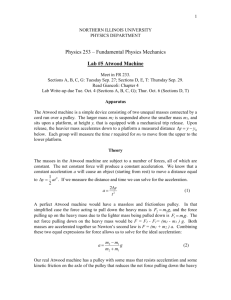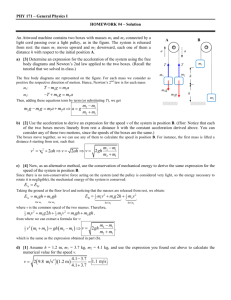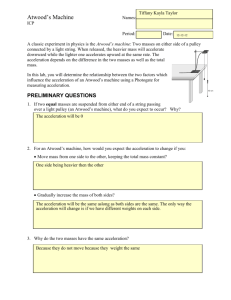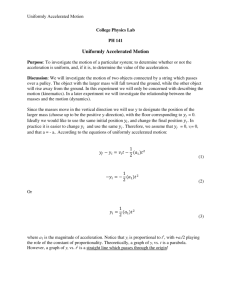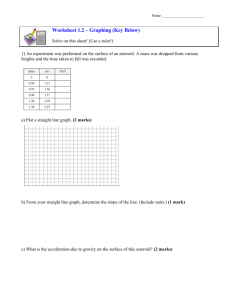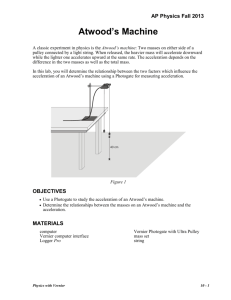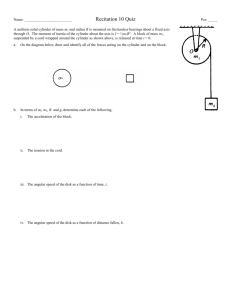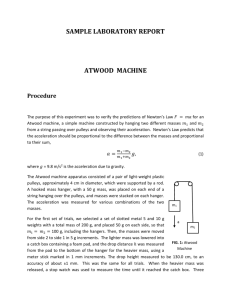Lab Description
advertisement
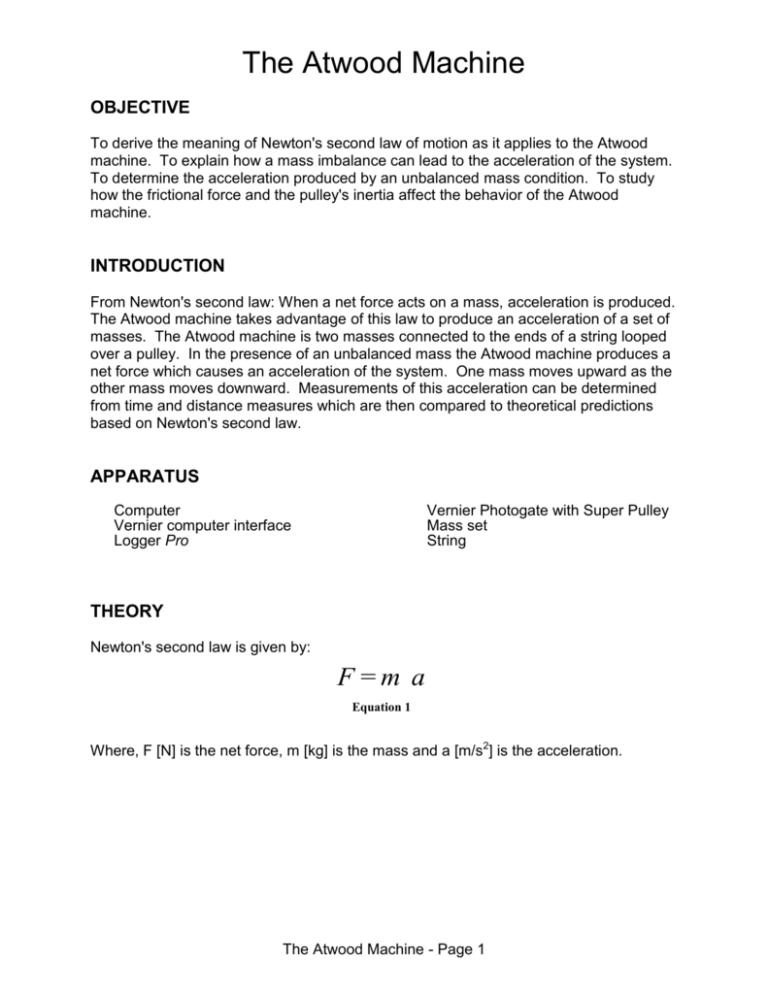
The Atwood Machine
OBJECTIVE
To derive the meaning of Newton's second law of motion as it applies to the Atwood
machine. To explain how a mass imbalance can lead to the acceleration of the system.
To determine the acceleration produced by an unbalanced mass condition. To study
how the frictional force and the pulley's inertia affect the behavior of the Atwood
machine.
INTRODUCTION
From Newton's second law: When a net force acts on a mass, acceleration is produced.
The Atwood machine takes advantage of this law to produce an acceleration of a set of
masses. The Atwood machine is two masses connected to the ends of a string looped
over a pulley. In the presence of an unbalanced mass the Atwood machine produces a
net force which causes an acceleration of the system. One mass moves upward as the
other mass moves downward. Measurements of this acceleration can be determined
from time and distance measures which are then compared to theoretical predictions
based on Newton's second law.
APPARATUS
Computer
Vernier computer interface
Logger Pro
Vernier Photogate with Super Pulley
Mass set
String
THEORY
Newton's second law is given by:
F=m a
Equation 1
Where, F [N] is the net force, m [kg] is the mass and a [m/s2] is the acceleration.
The Atwood Machine - Page 1
Let us apply Newton's second law to the Atwood machine. We will analyze the forces
that are present on each of the masses in the system. Below is a representation of the
standard Atwood machine.
Figure 1
T
T
m1
m2
Where, m1 [kg] is mass #1, m2 [kg] is mass #2 and T [N] is the tension in the string (due
to gravity acting on the masses).
To best analyze the behavior of the two masses we will picture each mass with the
forces that act on each respectively.
T
T
Figure 2
m1
m2
m1 g
m2 g
In a balanced condition (equilibrium) m1 = m2 and the masses remain stationary. This,
however, does not allow the study of Newton's second law. Thus, let us consider the
case where m1 > m2. This condition gives m1 a greater downward attraction and thus, it
accelerates downward while m2 (attached via a light string to m1) will accelerate upward
with the same acceleration as m1. The downward acceleration of m1 will not equal the
acceleration due to gravity as the string, pulley, and m 2 are inhibiting a free-fall situation.
Therefore applying Equation 1 to Figure 1:
T = m1 g + m1 a
T = m2 g - m2 a
Equation 2
Where, a [m/s2] is the acceleration of the system. Equation 2 is derived from the sum of
the forces in the y-direction.
The Atwood Machine - Page 2
Because the string is connected between m1 and m2, and from Newton's third law, the
tension in the string is the same for both m1 and m2. Thus, setting the two equations in
Equation 2 equal based on the equal tensions gives:
m1 g + m1 a = m2 g - m2 a
or
m1 g - m2 g = - m1 a - m2 a
or
m2 g - m1 g = m1 a + m2 a
or
( m2 - m1 ) g = ( m1 + m2 ) a
Equation 3
Where, (m2 - m1)g [N] is the applied force that causes the acceleration a [m/s 2]. Note,
the acceleration of the system, based on Newton's second law, is derived solely from a
pair of masses and gravity.
To this point we have ignored the friction in and the inertia (tendency to remain at rest)
of the pulley. These quantities cannot, however, be neglected. As mass is a measure
of inertia, a percentage of the pulley's mass can be used as a measure of the pulley's
inertia (one-half the total mass of the pulley). To be more accurate in Equation 3, by
including the frictional forces (primarily of the pulley itself) and the pulley's inertia, the
following derivation is used:
F net = F - f = m a
or
( m2 - m1 ) g - f = ( m1 + m2 + m p ) a
Equation 4
Where, f [N] is the frictional force (opposite the applied force) and mp [kg] is the mass of
the pulley that factors into the inertia of the pulley. Both the frictional force and the
inertial mass will be experimentally determined quantities.
The Atwood Machine - Page 3
EXPERIMENTAL PROCEDURE
Figure 4
40 cm
Part I: Keeping The Total Mass Constant
For this part of the experiment you will keep the total mass used constant, but move
weights from one side to the other. The difference in masses changes.
1.
Set up the Atwood’s machine apparatus as shown in Figure 4. Be sure the
heavier mass can move at least 40 cm before striking the floor or table top.
2.
Connect the Photogate with Super Pulley to DIG/SONIC 1 of the interface.
3.
Open the file “10 Atwoods Machine” in the “_Physics with Vernier” folder. A graph
of velocity vs. time will be displayed.
4.
Arrange a collection of masses totaling 200 g {50g hanger, 100g, 20g, 10g, 10g,
5g, 5g} on m2 and a 200 g {50g hanger, 100g, 50g} mass on m1. These masses are
shown in the data table.
5.
Position m1 as high up as it can go and release. What's the acceleration of this
system? Is this expected? Record this value in the data table.
Move 5 g from m2 to m1.
6.
Position m1 as high up as it can go. Click
to begin data collection.
Steady the masses so they are not swinging. Wait at least one second and release the
masses. Catch the falling mass before it strikes the surface or the other mass strikes
the pulley.
7.
Click the Linear Fit button
to fit the line y = mt + b to the data. Slide the
brackets, [ ], into place to select the region of the graph where the velocity was
increasing at a steady rate (positive acceleration). Record the slope value (acceleration)
in the data table.
You will need one copy of this graph, with the brackets and data box included, for
your laboratory report. You need ONE printout total; NOT one for each trial.
Additionally, you will NOT need a second graph for the Part II data collection.
The Atwood Machine - Page 4
8.
Continue to move masses from m2 to m1 in 5 g increments, changing the
difference between the masses, but keeping the total constant. Repeat Steps 6 - 7 for
each mass combination. Repeat these steps through a mass difference of 50g.
Part II: Keeping The Mass Difference Constant
For this part of the experiment you will keep the difference in mass between the two
sides of the Atwood’s machine constant and increase the total mass.
9.
Put 120 g on m1 and 100 g on m2; these masses should include the mass of the
hanger!!
10.
Repeat Steps 6 & 7 to collect data and determine the acceleration.
11.
Add mass in 20 g increments to both sides, keeping a constant difference of 20
grams. The resulting mass for each combination are shown in the data table. Repeat
Steps 6 & 7 for each combination. Repeat the procedure through a total mass of 380g.
REPORT ITEMS
(To be submitted and stapled in the order indicated below)
(-5 points if this is not done properly)
COVER PAGE
Lab Title
Each lab group member’s first and last name printed clearly
Date
DATA (worth up to 10 points)
Data tables available as a downloadable Excel file
ONE sample Velocity vs. Time graph from the experimental trials that includes
the Linear Fit data box.
DATA ANALYSIS (worth up to 20 points)
Experimental Procedure Graph
-- Place analysis on the graph printout itself -
Using your Velocity vs. Time graph, explain what the graph is indicating about the
motion of the masses and why the region selected was appropriate.
The Atwood Machine - Page 5
Now...Remove the pulley from the assembly & examine it without the
string and masses hanging from it. Give it a spin with your finger.
Based on this examination, what approximations {large enough to
matter = you have to keep the term; small enough to be considered
negligible = can set the term equal to zero} can you make regarding
the mass of the pulley (mp; just the spinning disk part) and the
frictional forces (f) acting on the pulley as they relate to the
experiment and the data collected?
You’ll use these conclusions from the questions above when
discussing the equations for each part below.
Part I: Keeping The Total Mass Constant
We will begin with the equation:
( m1 + m2 + m p ) a ( m2 - m1 ) g - f
Rewrite the equation to reflect the new mp & f approximations you
concluded.
What quantity in the equation would you consider to be the mass
difference, m? Make this substitution and rewrite the equation again.
Solve this new equation for "a." It now represents a linear equation that
plots the acceleration [y-axis] vs. m [x-axis]
o Like This: a = (Slope Stuff) * m + Y-Intercept Stuff.
Your "slope stuff" may not literally be multiplied by m. The
point is that the "slope stuff" is ANYTHING in that part of the
equation that is NOT m!
Additionally, the "y-intercept stuff" might be zero.
Based on the basic form of the linear equation from the previous step,
which quantities in your new equation should correspond to:
o The slope?
o The y-intercept?
The Atwood Machine - Page 6
Part II: Keeping The Mass Difference Constant
We will again begin with the equation:
( m1 + m2 + m p ) a ( m2 - m1 ) g - f
Rewrite the above in the same way you did previously to reflect the
approximations you concluded about mp & f from your pulley examination.
What quantity in the equation would you expect to be the total mass, MT?
Make this substitution and rewrite the equation again.
Solve this new equation for "a." It now represents a linear equation that
plots the acceleration [y-axis] vs. 1/MT [x-axis].
o Like This: a = (Slope Stuff) *
1
𝑀𝑇
+ Y-Intercept Stuff
Your "slope stuff" may not literally be multiplied by 1/MT.
The point is that the "slope stuff" is ANYTHING in that part of
the equation that is NOT 1/MT!
Additionally, the "y-intercept stuff" might be zero.
Based on the basic form of the linear equation from the previous step,
which quantities in your new equation correspond to:
o The slope?
o The y-intercept?
GRAPHS (worth up to 10 points)
Part I: Keeping The Total Mass Constant
Unplug the Logger Pro from the computer and open a new, blank data table/graph
within the program [New Page Button/Icon]. Plot a graph of acceleration [y-axis] vs. m
[x-axis], using your Part I data.
Before you print this graph, AUTOSCALE the data and click the Linear Fit button
to fit the line y = mx + b to the data; displaying the data box containing the
slope and y-intercept data.
Part II: Keeping The Mass Difference Constant
Again, with the Logger Pro unplugged from the computer, open a new, blank data
table/graph within the program [New Page Button/Icon]. Plot a graph of acceleration [yaxis] vs. 1/MT [x-axis], using the Part II data.
Before you print this graph, AUTOSCALE the data and click the Linear Fit button
to fit the line y = mx + b to the data; displaying the data box containing the
slope and y-intercept data.
The Atwood Machine - Page 7
GRAPH ANALYSIS (worth up to 20 points)
Part I: Keeping The Total Mass Constant
-- Place analysis on the graph printout itself -
Based on your analysis of the graph, what is the relationship between the mass
difference and the acceleration of an Atwood’s machine?
How do your previous definitions of the slope and the y-intercept compare to the
results that you found experimentally; i.e. what should be the value of the slope
(from the equation) you found in the data analysis section vs. the value you actually
determined (from the graph)? How do you account for any differences?
Part II: Keeping The Mass Difference Constant
-- Place analysis on the graph printout itself -
Based on your analysis of the graph, what is the relationship between total mass
and the acceleration of an Atwood’s machine?
How do your previous definitions of the slope and the y-intercept compare to the
results that you found experimentally; i.e. what should be the value of the slope
(from the equation) you found in the data analysis section vs. the value you actually
determined (from the graph)? How do you account for any differences?
CONCLUSION (worth up to 20 points)
See the Physics Laboratory Report Expectations document for detailed
information related to each of the four questions indicated below.
1. What was the lab designed to show?
2. What were your results?
3. How do the results support (or not support) what the lab was supposed to
show?
4. What are some reasons that the results were not perfect?
QUESTIONS (worth up to 10 points)
DO NOT forget to include the answers to any questions that were asked within
the experimental procedure
1) How should the tension in the string change from trial to trial for the Keeping The
Total Mass Constant cases?
2) How should the tension in the string change from trial to trial for the Keeping The
Mass Difference Constant cases?
3) Should the mass of the string be added to the equations you graphed (from page 6)
to obtain better accuracy? Explain.
The Atwood Machine - Page 8
